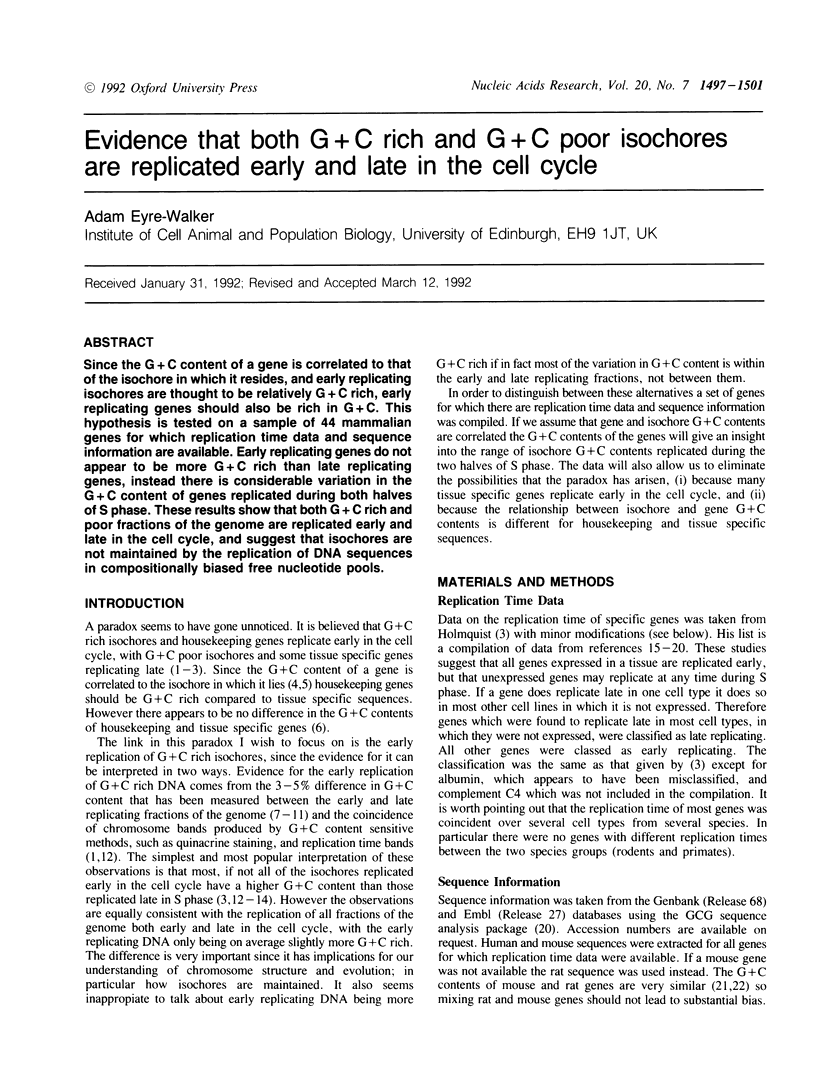Abstract
Since the G + C content of a gene is correlated to that of the isochore in which it resides, and early replicating isochores are thought to be relatively G + C rich, early replicating genes should also be rich in G + C. This hypothesis is tested on a sample of 44 mammalian genes for which replication time data and sequence information are available. Early replicating genes do not appear to be more G + C rich than late replicating genes, instead there is considerable variation in the G + C content of genes replicated during both halves of S phase. These results show that both G + C rich and poor fractions of the genome are replicated early and late in the cell cycle, and suggest that isochores are not maintained by the replication of DNA sequences in compositionally biased free nucleotide pools.
Full text
PDF




Selected References
These references are in PubMed. This may not be the complete list of references from this article.
- Aïssani B., D'Onofrio G., Mouchiroud D., Gardiner K., Gautier C., Bernardi G. The compositional properties of human genes. J Mol Evol. 1991 Jun;32(6):493–503. doi: 10.1007/BF02102651. [DOI] [PubMed] [Google Scholar]
- Bernardi G., Mouchiroud D., Gautier C., Bernardi G. Compositional patterns in vertebrate genomes: conservation and change in evolution. J Mol Evol. 1988 Dec;28(1-2):7–18. doi: 10.1007/BF02143493. [DOI] [PubMed] [Google Scholar]
- Bernardi G., Olofsson B., Filipski J., Zerial M., Salinas J., Cuny G., Meunier-Rotival M., Rodier F. The mosaic genome of warm-blooded vertebrates. Science. 1985 May 24;228(4702):953–958. doi: 10.1126/science.4001930. [DOI] [PubMed] [Google Scholar]
- Bernardi G. The isochore organization of the human genome. Annu Rev Genet. 1989;23:637–661. doi: 10.1146/annurev.ge.23.120189.003225. [DOI] [PubMed] [Google Scholar]
- Calza R. E., Eckhardt L. A., DelGiudice T., Schildkraut C. L. Changes in gene position are accompanied by a change in time of replication. Cell. 1984 Mar;36(3):689–696. doi: 10.1016/0092-8674(84)90349-0. [DOI] [PubMed] [Google Scholar]
- Comings D. E. Mechanisms of chromosome banding and implications for chromosome structure. Annu Rev Genet. 1978;12:25–46. doi: 10.1146/annurev.ge.12.120178.000325. [DOI] [PubMed] [Google Scholar]
- Comings D. E. Replicative heterogeneity of mammalian DNA. Exp Cell Res. 1972 Mar;71(1):106–112. doi: 10.1016/0014-4827(72)90269-8. [DOI] [PubMed] [Google Scholar]
- Davisson M. T., Lalley P. A., Peters J., Doolittle D. P., Hillyard A. L., Searle A. G. Report of the comparative subcommittee for human and mouse homologies. Cytogenet Cell Genet. 1990;55(1-4):434–456. doi: 10.1159/000133026. [DOI] [PubMed] [Google Scholar]
- Devereux J., Haeberli P., Smithies O. A comprehensive set of sequence analysis programs for the VAX. Nucleic Acids Res. 1984 Jan 11;12(1 Pt 1):387–395. doi: 10.1093/nar/12.1part1.387. [DOI] [PMC free article] [PubMed] [Google Scholar]
- Filipski J., Salinas J., Rodier F. Two distinct compositional classes of vertebrate gene-bearing DNA stretches, their structures and possible evolutionary origin. DNA. 1987 Apr;6(2):109–118. doi: 10.1089/dna.1987.6.109. [DOI] [PubMed] [Google Scholar]
- Flamm W. G., Bernheim N. J., Brubaker P. E. Density gradient analysis of newly replicated DNA from synchronized mouse lymphoma cells. Exp Cell Res. 1971 Jan;64(1):97–104. doi: 10.1016/0014-4827(71)90197-2. [DOI] [PubMed] [Google Scholar]
- Goldman M. A., Holmquist G. P., Gray M. C., Caston L. A., Nag A. Replication timing of genes and middle repetitive sequences. Science. 1984 May 18;224(4650):686–692. doi: 10.1126/science.6719109. [DOI] [PubMed] [Google Scholar]
- Goldman M. A. The chromatin domain as a unit of gene regulation. Bioessays. 1988 Aug-Sep;9(2-3):50–55. doi: 10.1002/bies.950090204. [DOI] [PubMed] [Google Scholar]
- Hatton K. S., Dhar V., Brown E. H., Iqbal M. A., Stuart S., Didamo V. T., Schildkraut C. L. Replication program of active and inactive multigene families in mammalian cells. Mol Cell Biol. 1988 May;8(5):2149–2158. doi: 10.1128/mcb.8.5.2149. [DOI] [PMC free article] [PubMed] [Google Scholar]
- Holmquist G. P. Evolution of chromosome bands: molecular ecology of noncoding DNA. J Mol Evol. 1989 Jun;28(6):469–486. doi: 10.1007/BF02602928. [DOI] [PubMed] [Google Scholar]
- Holmquist G., Gray M., Porter T., Jordan J. Characterization of Giemsa dark- and light-band DNA. Cell. 1982 Nov;31(1):121–129. doi: 10.1016/0092-8674(82)90411-1. [DOI] [PubMed] [Google Scholar]
- Iqbal M. A., Chinsky J., Didamo V., Schildkraut C. L. Replication of proto-oncogenes early during the S phase in mammalian cell lines. Nucleic Acids Res. 1987 Jan 12;15(1):87–103. doi: 10.1093/nar/15.1.87. [DOI] [PMC free article] [PubMed] [Google Scholar]
- Iqbal M. A., Plumb M., Stein J., Stein G., Schildkraut C. L. Coordinate replication of members of the multigene family of core and H1 human histone genes. Proc Natl Acad Sci U S A. 1984 Dec;81(24):7723–7727. doi: 10.1073/pnas.81.24.7723. [DOI] [PMC free article] [PubMed] [Google Scholar]
- Leeds J. M., Slabaugh M. B., Mathews C. K. DNA precursor pools and ribonucleotide reductase activity: distribution between the nucleus and cytoplasm of mammalian cells. Mol Cell Biol. 1985 Dec;5(12):3443–3450. doi: 10.1128/mcb.5.12.3443. [DOI] [PMC free article] [PubMed] [Google Scholar]
- McAlpine P. J., Stranc L. C., Boucheix C., Shows T. B. The 1990 catalog of mapped genes and report of the nomenclature committee. Cytogenet Cell Genet. 1990;55(1-4):5–76. doi: 10.1159/000132995. [DOI] [PubMed] [Google Scholar]
- McCormick P. J., Danhauser L. L., Rustum Y. M., Bertram J. S. Changes in ribo- and deoxyribonucleoside triphosphate pools within the cell cycle of a synchronized mouse fibroblast cell line. Biochim Biophys Acta. 1983 Mar 15;756(1):36–40. doi: 10.1016/0304-4165(83)90021-1. [DOI] [PubMed] [Google Scholar]
- Mouchiroud D., Fichant G., Bernardi G. Compositional compartmentalization and gene composition in the genome of vertebrates. J Mol Evol. 1987;26(3):198–204. doi: 10.1007/BF02099852. [DOI] [PubMed] [Google Scholar]
- Mouchiroud D., Gautier C., Bernardi G. The compositional distribution of coding sequences and DNA molecules in humans and murids. J Mol Evol. 1988;27(4):311–320. doi: 10.1007/BF02101193. [DOI] [PubMed] [Google Scholar]
- Tobia A. M., Schildkraut C. L., Maio J. J. Deoxyribonucleic acid replication in synchronized cultured mammalian cells. I. Time of synthesis of molecules of different average uanine + cytosine content. J Mol Biol. 1970 Dec 28;54(3):499–515. doi: 10.1016/0022-2836(70)90122-1. [DOI] [PubMed] [Google Scholar]
- Wolfe K. H. Mammalian DNA replication: mutation biases and the mutation rate. J Theor Biol. 1991 Apr 21;149(4):441–451. doi: 10.1016/s0022-5193(05)80092-x. [DOI] [PubMed] [Google Scholar]
- Wolfe K. H., Sharp P. M., Li W. H. Mutation rates differ among regions of the mammalian genome. Nature. 1989 Jan 19;337(6204):283–285. doi: 10.1038/337283a0. [DOI] [PubMed] [Google Scholar]


